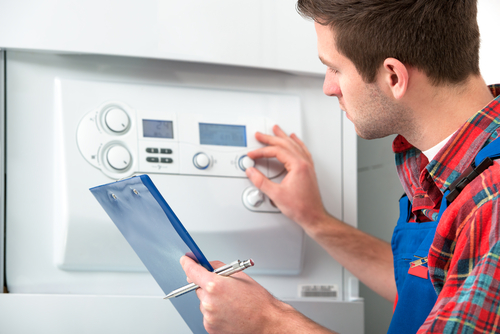Dealing with a how to fix a leaking stopcock? You're not alone. This common household issue can lead to wasted water and an unwelcome hike in your bills. But don't worry, getting it sorted is more straightforward than you might think.
In this guide, we'll walk you through the essentials of your home's water supply system and shed light on why knowing your stopcocks could be a lifesaver during emergencies. We’ll delve into the anatomy of these crucial components, pinpointing where leaks often occur - from compression nuts to gland nuts and head gear joints.
Armed with our step-by-step instructions, you'll soon have the confidence to tackle those pesky leaks like a pro – saving both water and peace of mind.
Beyond Just Tightening: What If Your Fixes Falter?
Table of Contents:
- Understanding Your Home's Water Supply System
- Anatomy of a Stopcock and Common Leak Points
- Diagnosing and Fixing Leaking Compression Nuts
- Repairing a Leaking Gland Nut Effectively
- Advanced Repairs on Leaking Head Gear Joints
- Conclusion
Understanding Your Home's Water Supply System
A solid grasp of your home's water supply is essential.The Role of Stopcocks in Water Flow Control
Stopcocks are the unsung heroes when it comes to controlling water flow. Your mains valve, also known as a stopcock, acts as the gatekeeper, deciding whether water enters your property or not. It is usually a lever valve that you can turn to gain control over the mains water supply. If you have a leak, finding and using the stop tap quickly is crucial.Inside vs. Outside Stopcocks: Responsibilities and Locations
There are two stopcocks, one inside and one outside. The inside stopcock is your responsibility and is usually located under the kitchen sink or near where the water main enters your property. You have control over this stopcock in case of emergencies. The outside stopcock is located close to boundaries, such as paths or gardens. If any issues arise with the outside stopcock, you should contact your water supplier for assistance.Quick Actions During Water Emergencies
During sudden leaks, quick thinking and knowing what to do are essential.- If a disaster strikes, the first step is to turn off the internal stopcock. Make sure to shut off all running taps before turning any valves.
- If there is a rush of water by your kitchen sink, quickly stop it by firmly turning the mains valve.
- If all else fails, reach out for help from your water supplier's emergency line. They will be able to assist you promptly.
Anatomy of a Stopcock and Common Leak Points
An overview of the components that make up a stopcock and where leaks are most likely to happen.Compression Nuts and Their Role in Sealing Connections
Understanding how compression nuts ensure a tight seal in pipe fittings and what causes them to leak. Compression nuts bring pipes together like old friends. They create a tight seal, stopping water from crashing the party where it shouldn't. However, sometimes they fail due to corrosion or just bad luck. When a compression nut starts leaking, you'll spot damp patches faster than you can say 'leak'.Gland Nut's Function in Preventing Leaks
Detailing the purpose of a gland nut in a stopcock and how it can become a source of leaks. The gland nut is the unsung hero keeping leaks at bay, but when it sings out of tune, drips follow. If your stopcock is weeping more than an emotional film ending, chances are the gland nut has lost its grip. Tightening might help, but if not, consider repacking it with fresh sealing material like Screwfix Select PTFE tape.Head Gear Joint Vulnerabilities
Discussing the complexities of the head gear joint in a stopcock and why it might start leaking. A leaky head gear joint has all eyes on it – notorious for causing puddles where you least expect them. This troublemaker is located at the top of your stopcock, and it's like wearing a hat that doesn't fit - awkward. The head gear joint keeps everything running smoothly, until it doesn't. If there's leakage here, consider renewing the parts before they throw a spanner into your day-to-day life and possibly flood your kitchen sink.Diagnosing and Fixing Leaking Compression Nuts
Tools Required for Addressing Compression Nut Leaks
Gather your kit. You'll need water pump pliers, a suitable spanner, and patience. Good lighting helps too. A small leak can become a big problem. That's why it's essential to have the right tools on hand when you're looking to fix leaking compression nuts. The essentials include water pump pliers and an adjustable spanner – they’re non-negotiables in this game of drips and drops.Finding the Culprit: The Leak Source
Your stopcock is dripping? Time to play detective. First off, check if it’s the compression nut that’s leaking. This little guy secures pipe connections so tightness is key here but not over-tightening; we don’t want any cracked pipes.Tighten It Right: No More Drips
If you’ve spotted a slight seepage around your compression nut, reach for those trusty water pump pliers or that handy adjustable spanner. Gently does it - tighten just enough to halt the flow without straining pipes or joints; think firm handshake rather than arm wrestle champion grip.Nailing Down Tightness Without Overdoing It
- Check snugness with fingers first before reaching for tools.
- A quarter turn at most should do once resistance kicks in.
- If still weeping after tightening, read on...
Persistent Puddles? Wrap Up With PTFE Tape
- Damp spot persists despite tweaking? Get ready to wrap ptfe tape around threads.
- Carefully unscrew said culprit (compression nut) first though.
- Clockwise wrapping keeps things orderly under pressure...
Hints from Experience: Wrapping Technique Matters
- No shortcuts. Each thread deserves attention – skimping now could mean puddles later...
- Lay flat layers overlapping slightly for seamless coverage.
- Snap back into place gently but confidently once wrapped up nice and snugly with ptfe tape... that oughta plug any pesky leaks coming through those threads.
Beyond Just Tightening: What If Your Fixes Falter?
Key Takeaway:
Got a dripping stopcock? Grab water pump pliers and an adjustable spanner to tackle those compression nuts. Remember, it's all about the right touch – tighten like you're shaking hands, not wrestling. If leaks linger, wrap PTFE tape clockwise for watertight threads.
Repairing a Leaking Gland Nut Effectively
Gland nut leaks can throw a spanner in the works. It's more than just an annoyance; it disrupts your home's water harmony. But don't fret, fixing it is doable with some DIY savvy.When Tightening Isn't Enough - Replacing Gland Nut Packing
Sometimes, tightening gland nut simply won’t cut it. If you've tried cranking that sucker and the drip-drip persists, consider replacing packing gland nut as your next move. Packing replacement isn’t rocket science but does need patience and care. Let’s talk tools first: You’ll want to arm yourself with pump pliers or a suitable spanner from your toolkit arsenal for this operation. Ahead of anything else, make sure to shut off your mains water supply; otherwise you're looking at an indoor pool situation nobody asked for. Once done, open up the nearest tap to release any trapped pressure – think of it like letting out steam before cooking begins. Dismantling time. Loosen up that leaking gland nut gently—no brute force needed here—and peel away the old offender (that's our worn-out packing). A word of advice? Keep kitchen roll handy because even heroes need to mop up their battles sometimes. With clear access now granted by removing the leaky culprit parts, take this chance to clean around threads inside valve body too—it never hurts being thorough. Moving on to new packing which often comes in hero-material form: PTFE tape . This stuff will help create a watertight seal worthy of applause once wound neatly around valve stem under where packings go—you got this.- Cut enough length — about 20cm should suffice — then wrap ptfe tape clockwise if you’re facing towards spindle top end until layers look generous but not overboard; roughly six times round usually hits sweet spot nicely.
- The trick lies within keeping tension consistent throughout winding process so no gaps appear ready-to-spring future leaks upon us again.
- No shortcuts allowed here—we aim for longevity after all.
- Screwfix Select is my usual port-of-call when stock-up missions call though other hardware stores hold similar stocks.
- With PTF, you'll find a versatile tool that's essential for various applications. It provides an effective solution to meet your project requirements.
Key Takeaway:
Got a pesky gland nut leak? Tightening might not be enough. Replace the packing with patience and PTFE tape for a watertight seal that lasts.
To tackle this DIY fix, shut off your water supply first to avoid an indoor flood. With pump pliers in hand, remove the old packing and clean up before wrapping new PTFE tape around the valve stem properly—no shortcuts.
Advanced Repairs on Leaking Head Gear Joints
A leaking head gear joint can turn your day sour. Before you start, make sure to shut off the water supply.The Intricacies of a Leaking Head Gear Joint
You've spotted a leak at the stopcock's head gear joint? You're not alone. It’s often due to wear and tear or corrosion over time. Luckily, with some know-how, you can fix this common issue without breaking into a sweat.Tackling The Leak: Step-by-Step Guide
First things first: gather your tools. You'll need an adjustable spanner and pipe grips for starters. These are key in providing enough torque while protecting the valve body from damage as you work on tightening or replacing parts.Dismantling With Care
Carefully dismantle the handle and shield of the stopcock using your tools; remember that forceful handling could cause more damage than good here. Your aim is to expose the valve stem so that it becomes accessible for repairs without damaging any other part of your plumbing system.Gland Nut Inspection Time
Once inside, check out if there's visible damage around the gland nut – think cracks or noticeable wear signs. A compromised gland nut might just be why water has been making an unwanted appearance outside its designated pipes.Packing Replacement Is Key
If tightening doesn't cut it, consider repacking or replacing altogether - yes we’re talking about new PTFE tape wrapping around threadings which will help seal off potential escape routes for water trying its luck past worn-out seals. Use quality PTFE tape wrapped snugly but not too tightly; after all balance is everything when dealing with delicate components like these.New Washers Make All The Difference
Next up , washer inspection . Worn washers mean trouble , they should sit flush against surfaces creating watertight barriers . Swap old ones out for fresh counterparts ; something as simple as changing a washer can have surprisingly big impacts . Don’t forget lock nuts either — secure them firmly but avoid overtightening lest threads strip leaving bigger headaches behind .Final Checks And Reassembly
With new packing material set , reassemble carefully ensuring every component fits back perfectly into place including lever valves now ready once again control flow precisely according demand within household settings . Ensure each screwfix select piece aligns correctly preventing further leakage issues down line thereby safeguarding integrity entire system long term basis thanks attention detail throughout process repair itself .
Key Takeaway:
Spotted a leak in your stopcock's head gear joint? Don't panic. With the right tools like an adjustable spanner and pipe grips, you can tackle this fix yourself. Start by shutting off the water supply and then carefully dismantle to reach the valve stem. Inspect for damage, replace worn parts such as gland nuts or washers with quality replacements, and reassemble with precision to prevent future leaks.



